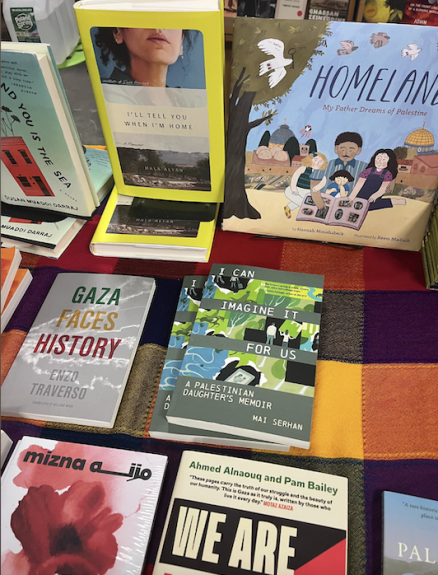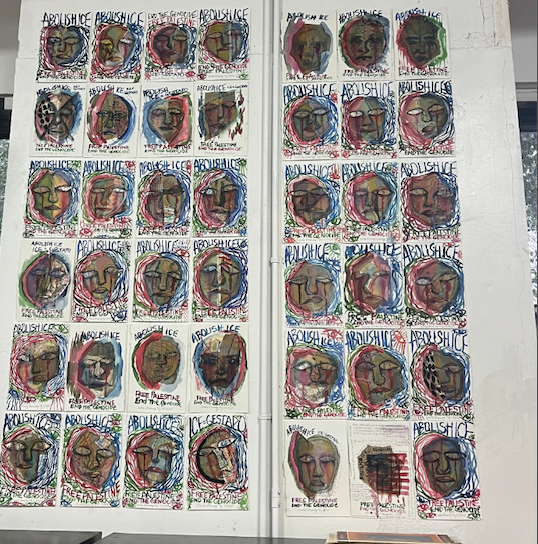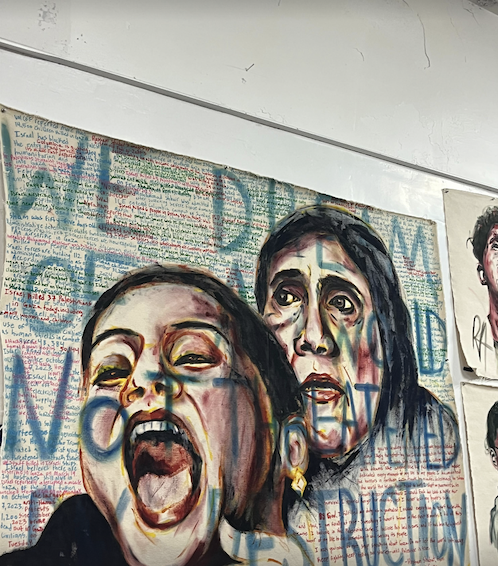On October 12 at Recirculation Bookstore, Bwog Staff visited Hind’s House—a three-day exhibition with vendors, workshops, and discussions–run by members of the Columbia community and other leftist organizations. The name Hind refers to Hind Rajab, a young Palestinian girl killed by Israeli forces during the war in Gaza.
Right at the front door to the bookstore, a statement issued by The Hind’s House was printed out for all participants to read. An excerpt reads:
“This exhibition calls for a permanent posture of outreach and teaching, for a culture of mutual responsibility that makes silence impossible.”
Inside the bookstore, there were many vendors at tables selling everything from political pins to paintings and jewelry, with proceeds going to Palestinian mutual aid collectives. Books, too, were on display: not only memoirs of Palestinian activists, but also children’s books exploring the history of the occupation. The bookstore had something for everyone.

Every hour, a workshop or teach-in began. The film “To Kill a War Machine,” was screened, a movie that follows Palestinian activists in their protest of Elbit Systems weapons manufacturing. Columbia University Apartheid Divest (CUAD) gave a teach-in, there were ICE watch trainings, and even letter-writing for political prisoners. Hind’s House became a space for “learning, organizing, and remembering.”
Bwog Staff attended the “De-militarize the Brooklyn Navy Yard” teach-in, which was about the struggle for terminating leases to weapons manufacturing companies with headquarters in the Brooklyn Navy Yard, a hub for technology and manufacturing. The teach-in focused mainly on organizing efforts to disrupt the proceedings of Easy Aerial and Crye Precision, two companies that produce technology used by ICE and the Israel Defense Forces.
Easy Aerial is a drone company that has contracts with both the US Air Force and the Department of Defense. The unmanned drones they make have been used by ICE to surveil minority communities around the US, collecting information using computer algorithms. “This leaves communities feeling unsafe, especially the communities living right next to the Navy Yard,” emphasized organizers. Crye Precision, a clothing company, manufactures army hats and uniforms for SWAT teams and camouflage uniforms used by the IDF. Crye Precision also has contracts with the United States, Canada, and other countries, providing them with uniform technology. Both of these companies have ties to local universities and high schools, offering internships and jobs for students.
As far as tactics for protesting these companies’ presence in the Navy Yard, the organizers emphasized “targets that are tangible” to make a difference, which are the two companies targeted by the current protest. Protests include picketing of workers, building coalitions between workers and tenants living in the area, and involving campaigns. The organizers mentioned that a “multiplicity of tactics” would have a greater impact rather than focusing only on one goal. The organization is also de-centralized, allowing for the community to work together rather than “petitioning politicians who don’t share the same interests,” as organizers said.

Organizers also encouraged listeners to attend the “Flood Brooklyn Navy Yard Open House” on Saturday, October 18, an event to “demand genocide and deportation profiteers out of Brooklyn Navy Yard,” while BNY hosts their annual open house.
Once the teach-in was over, Bwog Staff took a look at some of the vendors. One of the vendors, Ray Atlas (BC ‘26), was selling her oil paintings of Palestinian individuals and families to raise money for things like food, housing, and medical care. One of Atlas’ paintings depicted a wounded child at al Aqsa Hospital, based on a photograph by Marwan Saleh (top right painting). The proceeds from that painting will benefit a family of 7, including 5-year-old Mohammed and his father Mahmoud, an amputee. Atlas also displayed much larger oil paintings on the surrounding walls, part of her series “We dream of a world not threatened by destruction.”

Hind’s House Collective seeks to create a space for both difficult conversations and community healing. They emphasized how much stronger the movement is when groups are in coalition with one another. They reflected back on losses, like the one of Assata Shakur, a Black American political activist who passed last month. They also look toward the future with optimism, seeking to create a “world not threatened by destruction.” Even though organizations on Columbia’s campus have been repressed, Hind’s House Collective offers a different space to continue their activism.
All Photos via Author


 0 Comments
0 Comments